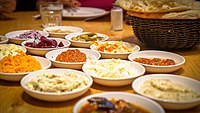Rosh Hanikra cheese
Script error: No such module "AfC submission catcheck".
| Rosh Hanikra Cheese | |
|---|---|
| Country of origin | Israel |
| Region | Northern Israel |
| Town | Rosh Hanikra |
| Source of milk | Goat or Cow |
| Texture | Soft |
| Aging time | 3 to 12 weeks |
| Named after | Lua error in Module:Wikidata at line 446: attempt to index field 'wikibase' (a nil value). |
Rosh Hanikra cheese or (Hebrew: גבינת ראש הנקרה) (gvinat Rosh Hanikra) in Hebrew is a type of soft, white cheese made with goat or cow's milk, produced in the Rosh Hanikra region of northern Israel. The cheese is made using milk from local farms, and it is known for its tangy flavor and creamy texture.[1][2][3][4][5][6][7][8]
Production[edit]
The production process for Rosh Hanikra cheese is similar to that of other soft cheeses. The goat milk is heated and then a bacterial culture and rennet are added to coagulate the milk. The resulting curds are then drained and shaped into molds, where they are allowed to age for several days. During this time, the cheese develops its characteristic tangy flavor and creamy texture. The production of Rosh Hanikra cheese is an important part of the local economy, and many small farms in the region specialize in dairy production. The farmers use traditional methods to produce the cheese. [7]
Uses[edit]
Rosh Hanikra cheese is often served as a table cheese or used in cooking. It pairs well with fresh fruits and vegetables, and it can also be melted over pasta dishes or used in sandwiches. [5]
The cheese has a distinct flavor that is influenced by the climate and soil conditions in the Rosh Hanikra region. The area's warm temperatures, salty air, and mineral-rich soil all contribute to the cheese's taste.[2]
Role in Tourism[edit]
In recent years[when?], efforts have been made to promote Rosh Hanikra cheese as a tourist attraction. Visitors to the region can visit local farms and cheesemakers, watch the cheese-making process, and sample the cheese. This has helped to raise awareness of the cheese and has also provided a boost to the local economy. [2]
See also[edit]
References[edit]
- ↑ Gur, Janna. The Book of New Israeli Food: A Culinary Journey. Search this book on

- ↑ 2.0 2.1 2.2 Gurevich and Wajswol, Katya and Eran. Cheese from the Land of Milk and Honey: A Guide to Israeli Cheese. Search this book on

- ↑ Ottolenghi and Tamimi, Yotam and Sami. Jerusalem: A Cookbook. Ten Speed Press. Search this book on

- ↑ Rothfeld, Steven. Israel Eats. Search this book on

- ↑ 5.0 5.1 Mayer-Chissick, Uri. The Secret Life of Cheese: The Complete Guide to Cheese and Cheese-Making in Israel. Search this book on

- ↑ Gitlitz and Davidson, David and Linda. Food in Israel: A Mediterranean Journey. Search this book on

- ↑ 7.0 7.1 Gur, Janna. Israel: A Culinary Journey. Search this book on

- ↑ Nathan, Joan. The Foods of Israel Today. Search this book on

- REDIRECT Template:Israeli cheeses
This article "Rosh Hanikra cheese" is from Wikipedia. The list of its authors can be seen in its historical and/or the page Edithistory:Rosh Hanikra cheese. Articles copied from Draft Namespace on Wikipedia could be seen on the Draft Namespace of Wikipedia and not main one.

